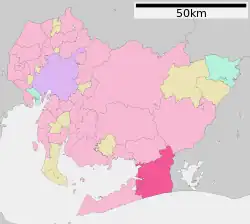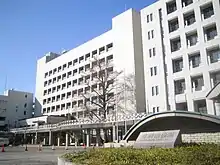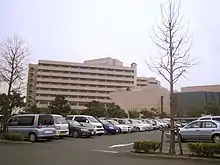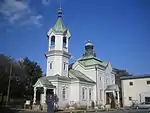Toyohashi
豊橋市 | |||||||||
|---|---|---|---|---|---|---|---|---|---|

| |||||||||
 Flag  Coat of arms | |||||||||
 Location of Toyohashi in Aichi Prefecture | |||||||||
 Toyohashi | |||||||||
| Coordinates: 34°46′9″N 137°23′29.5″E / 34.76917°N 137.391528°E | |||||||||
| Country | Japan | ||||||||
| Region | Chūbu (Tōkai) | ||||||||
| Prefecture | Aichi Prefecture | ||||||||
| Area | |||||||||
| • Total | 261.86 km2 (101.10 sq mi) | ||||||||
| Population (December 1, 2019) | |||||||||
| • Total | 377,453 | ||||||||
| • Density | 1,400/km2 (3,700/sq mi) | ||||||||
| Time zone | UTC+9 (Japan Standard Time) | ||||||||
| Phone number | 0532-51-2111 | ||||||||
| Address | 1 Imabashi-chō, Toyohashi-shi, Aichi-ken 440-8501 | ||||||||
| Climate | Cfa | ||||||||
| Website | Official website | ||||||||
| Symbols | |||||||||
| Flower | Azalea | ||||||||
| Tree | Camphor Laurel | ||||||||
Toyohashi (豊橋市, Toyohashi-shi) is a city in Aichi Prefecture, Japan. As of 1 December 2019, the city had an estimated population of 377,453 in 160,516 households [1] and a population density of 1,400 persons per km2. The total area of the city was 261.86 square kilometres (101.10 sq mi). By area, Toyohashi was Aichi Prefecture's second-largest city until March 31, 2005 when it was surpassed by the city of Toyota, which had merged with six peripheral municipalities.
Geography
Toyohashi is located in southeastern Aichi Prefecture, and is the capital of the informal "Higashi-Mikawa Region" of the prefecture. It is bordered by Shizuoka Prefecture to the east, and by Mikawa Bay and the headlands of the Atsumi Peninsula to the west. To the south is the Enshu Bay of the Pacific Ocean. The presence of the warm Kuroshio Current offshore gives the city a temperate climate. The Katahama Jusan-ri Beach (片浜十三里) in Toyohashi is a sea turtle nesting spot.
Climate
The city has a climate characterized by hot and humid summers, and relatively mild winters (Köppen climate classification Cfa). The average annual temperature in Toyohashi is 16.3 °C (61.3 °F). The average annual rainfall is 1,651.3 mm (65.01 in) with September as the wettest month. The temperatures are highest on average in August, at around 27.5 °C (81.5 °F), and lowest in January, at around 5.4 °C (41.7 °F).[2]
| Climate data for Toyohashi (2006−2020 normals, extremes 2005−present) | |||||||||||||
|---|---|---|---|---|---|---|---|---|---|---|---|---|---|
| Month | Jan | Feb | Mar | Apr | May | Jun | Jul | Aug | Sep | Oct | Nov | Dec | Year |
| Record high °C (°F) | 17.0 (62.6) |
19.5 (67.1) |
22.4 (72.3) |
26.0 (78.8) |
30.3 (86.5) |
34.1 (93.4) |
35.7 (96.3) |
37.9 (100.2) |
35.5 (95.9) |
30.8 (87.4) |
24.6 (76.3) |
22.4 (72.3) |
37.9 (100.2) |
| Mean daily maximum °C (°F) | 9.2 (48.6) |
10.4 (50.7) |
14.0 (57.2) |
18.6 (65.5) |
23.2 (73.8) |
25.9 (78.6) |
29.6 (85.3) |
31.5 (88.7) |
28.4 (83.1) |
23.2 (73.8) |
17.3 (63.1) |
11.8 (53.2) |
20.3 (68.5) |
| Daily mean °C (°F) | 5.4 (41.7) |
6.4 (43.5) |
9.5 (49.1) |
14.3 (57.7) |
19.0 (66.2) |
22.3 (72.1) |
26.0 (78.8) |
27.5 (81.5) |
24.4 (75.9) |
19.1 (66.4) |
13.3 (55.9) |
8.0 (46.4) |
16.3 (61.3) |
| Mean daily minimum °C (°F) | 1.9 (35.4) |
2.5 (36.5) |
5.2 (41.4) |
10.0 (50.0) |
15.1 (59.2) |
19.2 (66.6) |
23.2 (73.8) |
24.3 (75.7) |
21.0 (69.8) |
15.4 (59.7) |
9.3 (48.7) |
4.1 (39.4) |
12.6 (54.7) |
| Record low °C (°F) | −4.3 (24.3) |
−4.4 (24.1) |
−1.6 (29.1) |
1.3 (34.3) |
8.3 (46.9) |
12.9 (55.2) |
18.7 (65.7) |
19.3 (66.7) |
12.5 (54.5) |
6.5 (43.7) |
0.7 (33.3) |
−2.2 (28.0) |
−4.4 (24.1) |
| Average precipitation mm (inches) | 50.3 (1.98) |
79.9 (3.15) |
127.5 (5.02) |
150.9 (5.94) |
178.1 (7.01) |
184.6 (7.27) |
198.6 (7.82) |
126.8 (4.99) |
206.9 (8.15) |
210.9 (8.30) |
79.6 (3.13) |
57.2 (2.25) |
1,651.3 (65.01) |
| Average precipitation days (≥ 1.0 mm) | 5.3 | 6.4 | 8.4 | 9.3 | 8.9 | 11.3 | 10.8 | 7.1 | 10.7 | 10.0 | 6.7 | 5.5 | 100.4 |
| Mean monthly sunshine hours | 197.8 | 178.4 | 210.2 | 207.9 | 223.7 | 161.8 | 186.6 | 236.8 | 171.1 | 166.1 | 170.0 | 183.4 | 2,293.8 |
| Source: Japan Meteorological Agency[3][2] | |||||||||||||
Demographics

Per Japanese census data,[4] the population of Toyohashi has grown steadily over the past 60 years.
| Year | Pop. | ±% |
|---|---|---|
| 1950 | 185,984 | — |
| 1960 | 215,515 | +15.9% |
| 1970 | 258,547 | +20.0% |
| 1980 | 304,273 | +17.7% |
| 1990 | 337,982 | +11.1% |
| 2000 | 364,865 | +8.0% |
| 2010 | 376,861 | +3.3% |
Neighboring municipalities
City scape
 Skyline of Toyohashi
Skyline of Toyohashi
- The street in front of Toyohashi Station, 2022

 Toyohashi Zoo and Botanical Park
Toyohashi Zoo and Botanical Park
History
Origins
The area around present-day Toyohashi has been inhabited for many thousands of years. Archaeologists have found human remains from the Japanese Paleolithic period, which have been carbon dated to more than 10,000 BC along with the bones of Naumann elephants.
Numerous remains from the Jōmon period, and especially from the Yayoi and Kofun periods have also been found, including many kofun burial mounds.
During the Nara period, the area was assigned to Atsumi, Hoi and Yana Districts of Mikawa Province and prospered during subsequent periods as a post town on an important river crossing of the Tōkaidō connecting the capital with the eastern provinces.
Sengoku period
During the Sengoku period, the area was a highly contested zone between the Imagawa clan based in Suruga Province and various local warlords, who built a number of fortifications in the area, including Yoshida Castle. The rising power of the Matsudaira clan and its alliance with Oda Nobunaga eventually neutralized the threat posed by the Imagawa, and the area became part of the holdings of Tokugawa Ieyasu. Following the Battle of Odawara in 1590, Toyotomi Hideyoshi ordered the Tokugawa clan to relocate to the Kantō region and assigned the castle to Ikeda Terumasa. Ikeda developed the surrounding castle town and embarked on a massive and ambitious plan to rebuild Yoshida Castle. However, following the Battle of Sekigahara, he was relocated to Himeji Castle.
Edo period
After the establishment of the Tokugawa shogunate, Yoshida Castle became the center of Yoshida Domain, a clan fief. The domain was assigned to several different fudai daimyō clans until coming into the possession of the Matsudaira (Nagasawa-Ōkōchi) clan in 1752, which remained in residence at Yoshida until the Meiji Restoration. The final daimyō of Yoshida, Matsudaira Nobuhisa, surrendered the domain to the Meiji government in 1868. In 1869, the name of the domain was formally changed from Yoshida to Toyohashi.
Meiji period
With the establishment of the modern municipalities system under the Meiji government in 1879, Toyohashi Town was created within Atsumi District, Aichi Prefecture. Toyohashi Zoo was established in 1899. The town achieved city status in 1906.
Taishō period
A tram system (the present-day Toyohashi Railway Asumadai Main Line) was established in 1925.
Shōwa period
In 1932, Toyohashi expanded its borders by annexing Shimoji Town (Hoi District), Takashi Village, Muroyoshida Village (Atsumi District), and Shimokawa Village (Yana District). Toyohashi suffered considerable damage during the 1944 Tōnankai earthquake, and even more damage during the Toyohashi Air Raid, which destroyed more than 60% of the city in June 1945.
Modern Toyohashi
In 1955, Toyohashi's geographic extent was expanded again with the annexation of neighboring Maeshiba Village (Hoi District), Futagawa Village, Takatoyo Village, Oitsu Village (Atsumi District) and Ishimaki Village (Yana District). Toyohashi achieved core city status in 1999 with increased autonomy from the prefectural government.
Government


Mayor-council
Toyohashi has a mayor-council form of government with a directly elected mayor and a unicameral city legislature of 36 members.
Prefectural Assembly
The city contributes five members to the Aichi Prefectural Assembly.
House of Representatives
In terms of national politics, the city is part of Aichi District15 of the lower house of the Diet of Japan.
List of mayors of Toyohashi (from 1907)
|
|
|
Public
Police
- Aichi Prefectural Police
- Toyohashi police station
Firefighting
- Toyohashi Fire department
- Toyohashi-Minami fire department
- Toyohashi-Naka fire department
Health care
- Hospital
- Toyohashi City Hospital
Post office
- Toyohashi Post office
- Toyohashi-Minami Post office
Library
- Toyohashi City Library
- Toyohashi City Central Library
- Toyohashi City Mukaiyama Liburary
- Toyohashi City Oshimizu Liburary (Minakuru)
 Toyohashi Police Station
Toyohashi Police Station Toyohashi Fire Department
Toyohashi Fire Department Toyohashi City Hospital
Toyohashi City Hospital.jpg.webp) Toyohashi Post Office
Toyohashi Post Office Toyohashi City Central Library
Toyohashi City Central Library
International relations
Twin towns/sister cities
- Sister cities
 – Nantong, Jiangsu, China,[5] since May 1987
– Nantong, Jiangsu, China,[5] since May 1987 – Toledo, Ohio, United States since April 2000[6]
– Toledo, Ohio, United States since April 2000[6] – Panevėžys, Lithuania since June 2019[7]
– Panevėžys, Lithuania since June 2019[7]
- Friendship cities
Economy


Primary sector of the economy
Agriculture
Secondary sector of the economy
Industrial production is centered around the production of automotive-related components for Toyota, Mitsubishi, Suzuki Motors, and Honda, all of whom have factories in the region.
- Motors
Tertiary sector of the economy
- Worldwide trade
Mikawa Port is a major port for worldwide trade, and its presence has made Toyohashi the largest import and export hub in Japan for automobiles, in volume terms. Compared to other ports around the world, Mikawa is roughly on a par with the German port of Bremerhaven.[8]
- Shopping center
.jpg.webp) Cabbage field in Oshimizu-cho
Cabbage field in Oshimizu-cho.jpg.webp)
_-_panoramio.jpg.webp) Shopping Street
Shopping Street Cocola Avenue
Cocola Avenue
Media
Studio
- FM Toyohashi (JOZZ6AA-FM, 84.30 MHz)
Newspaper
- Higashi Aichi Newspaper
- Tonichi Shimbun Newspaper
Education

University
- National university
- Private university
- Private college
Primary and secondary schools
- Toyohashi has 52 public elementary schools and 22 public middle schools operated by the city government, and eight public high schools operated by the Aichi Prefectural Board of Education. The city also has one private middle school and three private high schools. The prefecture also operated three special education schools for the handicapped.
International schools
- Escola Alegria de Saber (エスコーラ・アレグリア・デ・サベール) - Brazilian school[9]
- Escola Cantinho Brasileiro (カンティーニョ学園) - Brazilian primary school[9]
- EJA Interativo – Educação de Jovens e Adultos - Brazilian institution[9]
- Toyohashi Korean Elementary School and Kindergarten (豊橋朝鮮初級学校) - North Korean school[10]
Transportation
Railway
Toyohashi Station is on the Tōkaidō Shinkansen and the Tōkaidō Main Line. Hikari shinkansen services stop at Toyohashi Station approximately once every two hours, and Kodama services stop twice an hour. Toyohashi Station is also the terminus of the Iida Line, Meitetsu Nagoya Main Line, Toyohashi Railroad Atsumi Line, and the Toyohashi Railroad Azumada Main Line, making it an important transportation hub.
Highspeed rail
Conventional lines
- Toyohashi Railroad Atsumi Line: Shin-Toyohashi • Yagyu-bashi • Koike • Aichidaigakumae • Minami-Sakae • Takashi • Ashihara • Ueta • Mukougaoka • Ōshimizu • Oitsu • Sugiyama
Tramway
- Toyohashi Railroad Azumada Main Line: Ekimae • Ekimae-ōdōri • Shinkawa • Fudagi • Shiyakushomae • Toyohashi-kōenmae • Higashi-hatchō • Maehata • Azumada-sakaue • Azumada • Keirinjōmae • Ihara • Akaiwaguchi
- Ihara • Undōkōen-mae
Bus
Almost all services are operated by Toyotetsu Bus, a subsidiary of Toyohashi Railroad.
Roads

Highway
Japan National Route
Sea port
- Port of Toyohashi (Port of Mikawa)

 Ekimae-Ôdôri Main street
Ekimae-Ôdôri Main street
 Toyotetsu Bus
Toyotetsu Bus Toyohashi Tollgate
Toyohashi Tollgate Port of Toyohashi
Port of Toyohashi
Local attractions
Places of interest
.jpg.webp)


- Toyohashi Park, which includes the site of Yoshida Castle (吉田城址), and the Toyohashi City Museum Art and History.
- Site of Nirengi Castle
- Toyohashi City Public Hall (豊橋市公会堂, Toyohashi-shi Kōkaidō), a National Important Cultural Property .[11]
- Toyohashi Orthodox Cathedral (豊橋ハリストス正教会), a National Important Cultural Property
- Futagawa-juku honjin museum
- Toyohashi Zoo
- Toyohashi Natural History Museum
- Toyohashi Museum of Natural Resources
Facilities and parks
Toyohashi has many parks, including the Natural History Museum and Zoological Park, the Imou swamp, Mikawa Seaside Forest, Kamo Iris Garden, and the Mukaiyama Ume Garden. It also has what is considered one of the best surfing beaches in Aichi and the surrounding region.[11]
Culture
Festivals
Toyohashi Festival, Spring Festival, Iris Flower Festival, Gion Festival, Demon Festival (February), and traditional marionette performances (Akumi joruri). At some of these festivals, especially the summer festivals, the use of traditionally handcrafted fireworks is showcased, and include hand-held bamboo-tube fireworks known as tezutsu hanabi.
Special products
Chikuwa (a type of baked sausage roll made from fish), Gohei rice cake (五平餅, Gohei-mochi), beach fermented soybeans, food boiled in goby fish and soy, top producer of quail eggs in Japan, Toyohashi calligraphy brush (豊橋筆, Toyohashi-fude).
In popular culture
In the fictional Harry Potter universe, Toyohashi is the hometown of the professional Quidditch team, the Toyohashi Tengu.[12]
In the Takeshi Kitano movie Kikujiro, the story revolves around the characters' trip from Tokyo to Toyohashi.
Sports
Basketball
Baseball
- Chunichi Dragons (Toyohashi Municipal Baseball Stadium)
Gallery
 Cocola Avenue
Cocola Avenue Matsuba Park
Matsuba Park Seapalace Resort
Seapalace Resort Aquarena Toyohashi
Aquarena Toyohashi Mukaiyama-Oike Ponds
Mukaiyama-Oike Ponds Toyohashi Orthodox Church
Toyohashi Orthodox Church_(10421329123).jpg.webp) Tezutsu Fireworks
Tezutsu Fireworks Toyohashi Oni Festival
Toyohashi Oni Festival
Notable people from Toyohashi
- Katsuhito Asano, Japanese politician
- Buyūzan Takeyoshi, sumo wrestler
- Daniel (Nushiro) of Japan, primate of Japanese Orthodox Church
- Atsushi Fujii, professional baseball player
- Emi Fujino, mixed martial artist, kickboxer and professional wrestler
- Mizuki Inoue, kickboxer and mixed martial artist
- Yoshitaka Iwamizu, Olympic long-distance runner
- Kitaro, musician
- Aya Kitō, writer
- Masaji Kiyokawa, Olympic gold-medalist swimmer
- Masatoshi Koshiba, Nobel Prize winner
- Ken Matsudaira, actor
- Rena Matsui, actress, former member of SKE48
- Yūji Mitsuya, actor, voice actor
- Masahiko Morifuku, professional baseball player
- Sakura Nogawa, voice actress
- Kenichi Ogawa, boxer
- Yoshio Sawai, manga artist
- Akiko Suzuki, professional figure skater
- Sakon Yamamoto, professional race car driver
- Yua Aida, AV idol and model
See also
References
- ↑ Toyohashi City official statistics (in Japanese)
- 1 2 気象庁 / 平年値(年・月ごとの値). JMA. Retrieved April 13, 2022.
- ↑ 観測史上1~10位の値(年間を通じての値). JMA. Retrieved April 13, 2022.
- ↑ Toyohashi population statistics
- 1 2 "International Exchange". List of Affiliation Partners within Prefectures. Council of Local Authorities for International Relations (CLAIR). Retrieved 21 November 2015.
- ↑ "Interactive City Directory". Sister Cities International. Retrieved 11 March 2014.
- ↑ "Miestai partneriai". panevezys.lt (in Lithuanian). Panevėžys. Retrieved 2019-08-28.
- ↑ Toyohashi City / Welcome
- 1 2 3 "Escolas Brasileiras Homologadas no Japão" (Archive). Embassy of Brazil in Tokyo. Retrieved on October 13, 2015.
- ↑ アクセス. Toyohashi Korean Elementary School and Kindergarten. Retrieved October 14, 2015.
愛知県豊橋市柳生町19
- 1 2 Toyohashi Culture Map
- ↑ Whisp, Kennilworthy (2001). Quidditch Through the Ages. WhizzHard Books. pp. 31–46. ISBN 1-55192-454-4.
External links
 Geographic data related to Toyohashi at OpenStreetMap
Geographic data related to Toyohashi at OpenStreetMap Toyohashi travel guide from Wikivoyage
Toyohashi travel guide from Wikivoyage- Official website (in Japanese)
